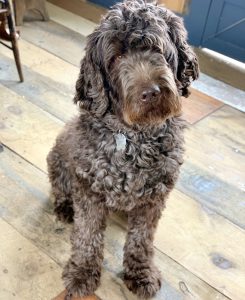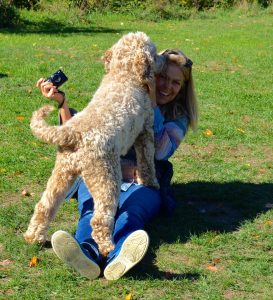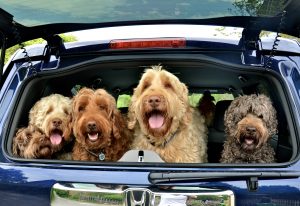Is the Cobberdog right for you?
The breed purpose of the Cobberdog is to have the qualities that make a great therapy dog. Those qualities include a dog that is friendly, patient and enjoys engaging with people. Our dogs here at Berkshire Hills have also been selectively bred to have a soft nature and are sensitive to people’s emotions. But those qualities need to be carefully shaped. Wrong understanding or a heavy hand can create a dog with behavior issues.
They are an awesome breed, but they are still dogs.They can be goofy, they can make messes, they need to learn how to live in our world, but do you have the patience to learn what they need and what they are trying to communicate with you?
Do you understand that it takes time and your effort for a puppy to become a calm and connected therapy and companion dog?
Are you prepared for:
1. Training your puppy with positive methods only? That means no choke, prong or shock collars? You can train your dog to have good manners through building a respectful relationship. Often people resort to punishment methods because they don’t know what else to do or not willing to take the time to learn. Find a good trainer who uses positive and relationship based training.
2. Having realistic expectations of your puppy’s first two years? People often meet an adult Berkshire Hills dog and expect the same calm and connected temperament in their puppy. I have had several people call me worried that their puppy doesn’t have a therapy dog temperament, they say the pup has too much energy, they pull on the leash, they are chewing things, etc. Those calls usually come when the dog hits adolescence!
It’s important to know that a puppy goes through many stages the first year or two. They nip, jump, poop in the house, have endless energy, go through fear stages, act like clowns and get into stuff and chew things, to name a few typical puppy behaviors. How you respond and work with those behaviors makes the difference in how your dog matures into an adult.
Cobberdogs are no different. The difference is that a Cobberdog has a soft nature. Punishment, misunderstanding or lack of patience can create anxiety in our dogs. The few dogs that have been returned to us usually have been the ones that were trained on a shock collar. They lost trust in their environment and their people, which caused fear and anxiety.
Building a respectful relationship is the key to creating the adult dog that connects with you and makes a good therapy dog.
- Cobberdogs need to be groomed every 8-10 weeks depending on the style you like. In between grooming appointments you will need to keep their hair around their eyes trimmed, nails clipped and ears cleaned.
4. Cobberdogs are alert barkers and will let you know if anyone is at the door, or an animal is in the yard and sometimes they alert you to things you just don’t see or hear (but they do!) At Berkshire Hills I appreciate the alert. The dogs stop once I go check it out. Do you have the patience to understand your dog’s nature and work with it?
Getting Ready for your Puppy
My favorite thing to do is write down a list of names for the new puppy, but there are other things to do to get ready for your puppy’s arrival that are just as important.
- Find a Vet. If you don’t have a vet already you’ll need to find one. Ask around for a good recommendation. Once you know your puppy’s arrival date then make an appointment within three days of his or her homecoming. Your vet will suggest a vaccination schedule, please find a vet who is open to minimal vaccinations and healthy real food diet.
2. Dog-Proof Your Home Prepare your home before your new dog arrives. Move breakables or “chewables” to higher ground. Make electrical cords inaccessible to curious paws and noses. Block off any area of the house that you want off-limits to the dog. Put the lid down on your toilet and your shoes up in your closet. Block access to any house or garden plants that may be toxic to dogs.
3. Order a Name Tag. Once you pick out your puppy’s name, order a name tag with your telephone and address. A cell# is helpful for when you travel. Bone shaped tags can get caught between the wires on a crate, so a round one is a better choice.
4. Buy a Collar and Leash. You’ll need an adjustable collar (around 8-16” ) for a medium or standard. Please don’t use a choke, prong or shock collar! A 4-6’ leash is a good all around length. I suggest you don’t use the retractable leash because it can be dangerous if the lead gets tangles around people to things.
5. Buy a Crate! A crate is a must for the safety of your puppy. Buy one that will fit your dog when full grown. One that is 36”Lx27”Hx24”W (large) will fit a medium-standard size Cobberdog. Find one that comes with a divider. I suggest a folding metal crate because it is cooler and the dog can see out. One that folds can easily be packed up and taken with you on a trip. A second crate is handy for night time while your puppy is sleeping next to your bed. A plastic one is fine for this.
6. Crate Mat: Sherpa Mats are the safest to use with puppies as they are pretty hard to chew. Please do not put a towel in your puppy’s crate because if they chew and injest parts of the towel the strings can cause a blockage.
7. Get your puppy water and food dishes.
8. Toys and more toys! Your puppy needs to chew and chew and chew. Suggestions are strong rubber and nylon toys, deer antlers, and kongs.
9. Training Start looking around for an obedience class (puppy class) that uses positive and relationship based training.
10. Books I recommend, The Puppy Primer by Patricia McConnell. You will also be given my book “Raising Your Soft Natured Puppy, Shaping Your Puppy to Become a Connected Companion and Therapy Dog” which has methods and suggestions that are made for Berkshire Hills puppies.
11. Pet insurance. I highly recommend getting it at least while your puppy is younger. An emergency surgery to remove a sock or some other object can be in the thousands. Ask your vet which ones they recommend.
12. Grooming Supplies
Slicker brush: Slicker brush comes in several sizes. I like a smaller one for when they are puppies and it is handy for their legs and heads once bigger. A larger one is good for when they are full grown.
Nail cutters: There are two kinds; the guillotine style and one with a stop. I find the guillotine style gives you more control, but it’s a personal choice.
Shears/scissorscan be very expensive but a basic pair with rounded ends are the safest choice for around the eyes, paws, and under ears.
Shampoo: Find a natural shampoo made for puppies that is gentle and tear-less. You should not use a human shampoo on your dog.
Ear Cleaner
Styptic Powder: stops bleeding if you cut the vein in the nail.
Other Useful Items:
Stain and odor remover such as Nature’s Miracle (get one with that has an enzyme to eliminate urine odors)
Metal gates with doors that swing open are wonderful to have. We use them all over the house when needed (they are spring mounted and can be moved)




